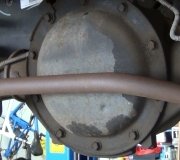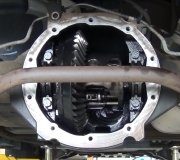Yes, it will roll away and you will have to run chasing after it! If the car rolls backward, the jacked-up tire will rotate forward.
Differentials are uncommonly easy to understand, and incredibly difficult to describe but I will try. The first photo shows the four small gears in every differential assembly. All the teeth are cut at a 45 degree angle so they can be assembled in a square, as shown in drawing # 1. A large 1"-diameter shaft runs through two of the gears as shown in drawing # 2. Those gears are free to rotate, or spin on that shaft.
An axle shaft running out to each drive wheel is splined to each of the side gears. Those are the blue shafts in figure 3. This is all that is involved when you are asking about spinning one wheel by hand. In figure 4, if you are looking down on the axle from above the vehicle, the black arrow shows the left axle shaft, and wheel, is being rotated forward. That causes the top gear to rotate in the direction of the red arrow, and that gear causes the right gear to rotate rearward, as shown by the orange arrow. The bottom gear rotates in the direction of the green arrow. The top and bottom gears always rotate in opposite directions, and the two side gears also always rotate in opposite directions. This is what you see when you rotate one wheel by hand and the other one goes the other way. Up to this point, the driveshaft is locked and cannot turn.
All of this is placed inside a housing a little larger than a pineapple. That housing is supported on a pair of large bearings making it free to rotate on them, as shown in figure 5. Those bearings are very carefully adjusted, then bolted tightly to the axle housing. It is what you see when the rear cover is removed.
Finally, in figure 6, a large, really beefy "ring" gear is bolted to the housing. That is the one with purple stripes. It meshes with the "pinion" gear that is driven by the driveshaft. It is the one with orange stripes.
When both tires are on the ground and have equal traction, the housing and the four small gears inside it are all turned as an assembly by the pinion gear turning the ring gear. Those small gears do not rotate by themselves until one of two things happens. The first is when the vehicle travels around a corner. Within the housing, one axle gear has to rotate a little forward since that wheel has to travel farther, and the other axle gear turns rearward because that wheel travels a shorter distance. This is hard to visualize because we pay more attention to the entire housing which is still rotating forward.
The second condition is when one tire is stuck on dry pavement and the other tire is slipping on ice. One revolution of the ring gear is supposed to turn both axle shafts, and both tires, one revolution, but when one tire with traction prevents that axle shaft from turning, the rotating housing causes a multiplying effect, and the spinning tire and axle shaft turns two revolutions.
To reduce the spinning of the tire on ice, a few different designs of "locking" differentials have been used. In the most common design, a group of small spring loaded clutch plates are stuck between the two side gears to more or less encourage the two axle shafts to always rotate in the same direction. They are loose enough that the outer wheel can still turn faster when going around a corner, but when one tire spins on ice, some of the driving force goes to the tire with traction. During normal driving, these four small gears rotate very little, and often not at all, so very little wear occurs to them. They only rotate a little when the two tires rotate at different speeds, which is mainly when cornering.
You will find the same arrangement in a front-wheel-drive vehicle, but without the driveshaft. Except for a very few specialized vehicles, and some International trucks from the 1960's, you will never find a locking differential in a front axle assembly. At highway speeds that would make for a very unstable handling vehicle with poor predictability. That is the sense that you know where to expect it to go when you turn the steering wheel.
Images (Click to make bigger)
Monday, August 6th, 2018 AT 10:59 PM






